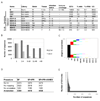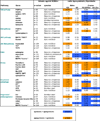Influence of Wolbachia on host gene expression in an obligatory symbiosis
- PMID: 22376153
- PMCID: PMC3287518
- DOI: 10.1186/1471-2180-12-S1-S7
Influence of Wolbachia on host gene expression in an obligatory symbiosis
Abstract
Background: Wolbachia are intracellular bacteria known to be facultative reproductive parasites of numerous arthropod hosts. Apart from these reproductive manipulations, recent findings indicate that Wolbachia may also modify the host's physiology, notably its immune function. In the parasitoid wasp, Asobara tabida, Wolbachia is necessary for oogenesis completion, and aposymbiotic females are unable to produce viable offspring. The absence of egg production is also associated with an increase in programmed cell death in the ovaries of aposymbiotic females, suggesting that a mechanism that ensures the maintenance of Wolbachia in the wasp could also be responsible for this dependence. In order to decipher the general mechanisms underlying host-Wolbachia interactions and the origin of the dependence, we developed transcriptomic approaches to compare gene expression in symbiotic and aposymbiotic individuals.
Results: As no genetic data were available on A. tabida, we constructed several Expressed Sequence Tags (EST) libraries, and obtained 12,551 unigenes from this species. Gene expression was compared between symbiotic and aposymbiotic ovaries through in silico analysis and in vitro subtraction (SSH). As pleiotropic functions involved in immunity and development could play a major role in the establishment of dependence, the expression of genes involved in oogenesis, programmed cell death (PCD) and immunity (broad sense) was analyzed by quantitative RT-PCR. We showed that Wolbachia might interfere with these numerous biological processes, in particular some related to oxidative stress regulation. We also showed that Wolbachia may interact with immune gene expression to ensure its persistence within the host.
Conclusions: This study allowed us to constitute the first major dataset of the transcriptome of A. tabida, a species that is a model system for both host/Wolbachia and host/parasitoid interactions. More specifically, our results highlighted that symbiont infection may interfere with numerous pivotal processes at the individual level, suggesting that the impact of Wolbachia should also be investigated beyond reproductive manipulations.
Figures



Similar articles
-
Wolbachia interferes with ferritin expression and iron metabolism in insects.PLoS Pathog. 2009 Oct;5(10):e1000630. doi: 10.1371/journal.ppat.1000630. Epub 2009 Oct 23. PLoS Pathog. 2009. PMID: 19851452 Free PMC article.
-
Wolbachia requirement for oogenesis: occurrence within the genus Asobara (Hymenoptera, Braconidae) and evidence for intraspecific variation in A. tabida.Heredity (Edinb). 2005 Nov;95(5):394-400. doi: 10.1038/sj.hdy.6800739. Heredity (Edinb). 2005. PMID: 16118660
-
Intra-individual coexistence of a Wolbachia strain required for host oogenesis with two strains inducing cytoplasmic incompatibility in the wasp Asobara tabida.Evolution. 2004 Oct;58(10):2167-74. doi: 10.1111/j.0014-3820.2004.tb01595.x. Evolution. 2004. PMID: 15562683
-
Drosophila-parasitoid communities as model systems for host-Wolbachia interactions.Adv Parasitol. 2009;70:299-331. doi: 10.1016/S0065-308X(09)70012-0. Adv Parasitol. 2009. PMID: 19773076 Review.
-
[Ultrastructural basis of interactions between prokaryotes and eukaryotes in different symbiotic models].Parassitologia. 2004 Jun;46(1-2):19-24. Parassitologia. 2004. PMID: 15305681 Review. Italian.
Cited by
-
Discovery of putative small non-coding RNAs from the obligate intracellular bacterium Wolbachia pipientis.PLoS One. 2015 Mar 4;10(3):e0118595. doi: 10.1371/journal.pone.0118595. eCollection 2015. PLoS One. 2015. PMID: 25739023 Free PMC article.
-
Autophagy regulates Wolbachia populations across diverse symbiotic associations.Proc Natl Acad Sci U S A. 2012 Jun 19;109(25):E1638-46. doi: 10.1073/pnas.1203519109. Epub 2012 May 29. Proc Natl Acad Sci U S A. 2012. PMID: 22645363 Free PMC article.
-
Host-Endosymbiont Genome Integration in a Deep-Sea Chemosymbiotic Clam.Mol Biol Evol. 2021 Jan 23;38(2):502-518. doi: 10.1093/molbev/msaa241. Mol Biol Evol. 2021. PMID: 32956455 Free PMC article.
-
Coevolution of hytrosaviruses and host immune responses.BMC Microbiol. 2018 Nov 23;18(Suppl 1):183. doi: 10.1186/s12866-018-1296-3. BMC Microbiol. 2018. PMID: 30470186 Free PMC article. Review.
-
Bacteria Endosymbiont, Wolbachia, Promotes Parasitism of Parasitoid Wasp Asobara japonica.PLoS One. 2015 Oct 22;10(10):e0140914. doi: 10.1371/journal.pone.0140914. eCollection 2015. PLoS One. 2015. PMID: 26492411 Free PMC article.
References
-
- Troll JV, Adin DM, Wier AM, Paquette N, Silverman N, Goldman WE, Stadermann FJ, Stabb EV, McFall-Ngai MJ. Peptidoglycan induces loss of a nuclear peptidoglycan recognition protein during host tissue development in a beneficial animal-bacterial symbiosis. Cell Microbiol. 2009;11:1114–1127. doi: 10.1111/j.1462-5822.2009.01315.x. - DOI - PMC - PubMed
Publication types
MeSH terms
LinkOut - more resources
Full Text Sources
Research Materials

